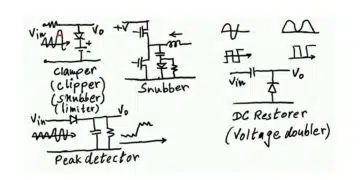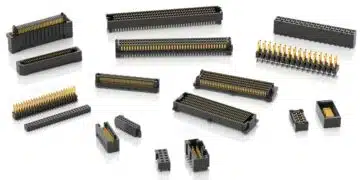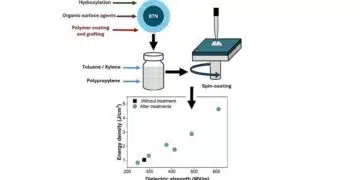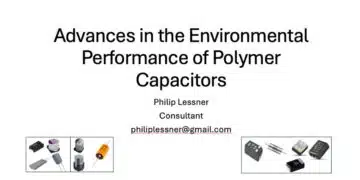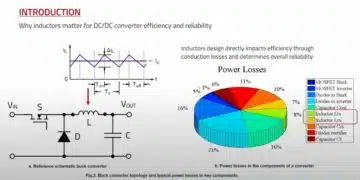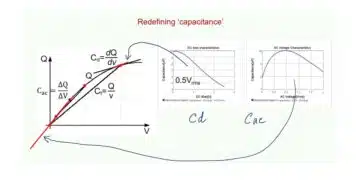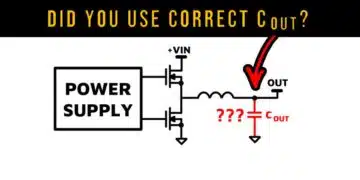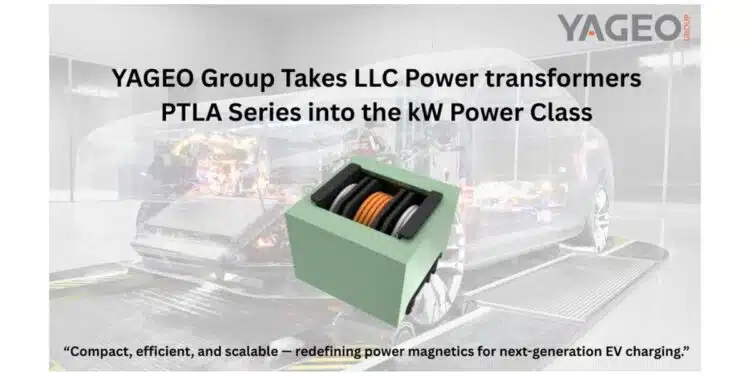YAGEO Group, a leader in Power Magnetics, announces the expansion of its Power Magnetics PTLA Series with the introduction of the PM9525NL LLC Transformer for OBC EV applications.
This cutting-edge 3.6kW transformer is specifically engineered for On-Board Charger (OBC) applications in electric vehicles, setting new standards in performance, scalability, and cost efficiency.
The PM9525NL is designed to deliver up to 470V battery voltage from mains power, all within a compact 52.8 × 52 × 43 mm form factor.
Its innovative magnetic design integrates 6.4µH of controlled leakage inductance on the primary side, eliminating the need for an external resonant inductor. This advancement reduces component count and Bill of Materials (BOM) cost, offering significant procurement advantages.
Technical Highlights:
- High power density with a 3.6kW OBC transformer
- Integrated 6.4µH leakage inductance for resonant operation
- 4.2kVrms isolation with 5mm creepage and clearance
- FEM validated for optimized flux linkage
- Scalable design for higher voltage and power applications
Procurement Advantages:
- Simplified system design with fewer components
- Compact, standardized footprint for easier integration
- Scalable manufacturing options and custom turns ratios
- Supported by YAGEO Group’s global network for sampling and volume supply
The PM9525NL is ideal for optimizing next-generation OBC systems and sourcing reliable magnetic components for large-scale production, providing the perfect balance of performance, reliability, and cost efficiency.
For more information, including the datasheet and a dedicated white paper on technical solutions, visit: PM9525NL LLC Transformer.
Case Study: Elimination Of The Discrete Resonant Inductor By The LLC Transformer
This study presents the 3.6 kW LLC transformer design for On-Board Charger (OBC) applications that achieves a tight-tolerance, primary-side concentrated leakage inductance so the transformer itself provides the resonant inductance for soft switching without a separate inductor. The target specifications include a turns ratio N of 2 (secondary to primary), a magnetizing inductance Lm of 36 μH, and a converter gain of 6. Because the LLC gain depends directly on the resonant inductance, the authors develop a bobbin and winding scheme that tunes the leakage inductance precisely and concentrates it on the primary side, then validate the approach with FEM simulation and electrical measurements.
Key points
- Objective: Eliminate the discrete resonant inductor by using tightly controlled transformer leakage inductance, while meeting gain and tolerance targets for a high-power OBC LLC converter.
- Design concept: Split primary with a sandwiched secondary on a PQ50/50 core, paired with a patented bobbin that precisely controls inter-winding spacing to tune leakage and maintain tight tolerance.
- Primary-side focus: Air-gap placement and magnetic path design increase reluctance for primary flux near the gap (reducing coupling to the secondary), while preserving strong coupling from secondary to primary—concentrating leakage on the primary.
- Verification: FEM flux path simulations and measurements confirm target inductances: Lm ≈ 36.4 μH, Lk_prim ≈ 6.5 μH, and a very small Lk_sec ≈ 0.04 μH.
- Impact: Precise resonant inductance without an external inductor improves tolerance control, simplifies the LLC tank, and supports high-efficiency soft-switching in multi-kW OBC systems.
The LLC converter’s soft switching hinges on the resonant tank formed by Lm, Lr, and Cr. For a target gain of 6, tight control of the resonant inductance Lr is essential. Traditionally, designers can integrate leakage inductance into the transformer to avoid a separate Lext, but controlling leakage as a parasitic with tight tolerance is challenging. This paper reframes the problem: if Lr is built from a designed, concentrated primary-side leakage inductance (Lk_prim), then precision can be achieved by structural features that deterministically set the inter-winding magnetic path.
To reach the needed ~6.4 μH leakage for the gain target, the authors adopt a PQ50/50 platform and a split primary with a sandwiched secondary. The patented bobbin geometry enables independent control of the separation between winding segments. By carefully selecting section widths and wire bundle sizes, the design minimizes variability in winding placement, which directly tightens the tolerance of Lk_prim. The result is a transformer whose leakage inductance is not merely incidental but deliberately engineered.
Magnetically, the approach relies on air-gap placement and path reluctance shaping. Since the core’s reluctance is far lower than air, the effective magnetic model simplifies with the air gap and inter-winding path (Rg and Rlk) dominating. Placing the gap to increase reluctance seen by primary flux reduces its coupling to the secondary, boosting primary-side leakage. Conversely, the secondary flux path experiences lower reluctance to the primary, minimizing secondary-side leakage. FEM results visualize distinct flux distributions that support this asymmetry: primary flux is impeded across the gap region, while secondary flux links more efficiently through the core to the primary.
Electrical validation uses standard measurements of inductance with open/short configurations and applies three equations to separate magnetizing and leakage components for each winding. These formulas isolate the actual primary leakage contributing to resonance (distinct from the traditional shorted-winding measurement that mixes reflected secondary leakage). The measured values meet targets with tight tolerance: magnetizing inductance at ~36.4 μH, primary leakage at ~6.5 μH, and secondary leakage reduced to ~0.04 μH. Small-signal induced voltage tests further confirm the design intent: with a turns ratio of 2, the induced primary voltage from a secondary excitation aligns closely with the ideal half-voltage, while the induced secondary voltage from primary excitation falls below the ideal double-voltage due to the substantial primary-side leakage—demonstrating the designed voltage division across Lk_prim versus Lm.
In practice, voltage divides between Lk and Lm according to impedance; significant Lk_prim reduces the induced secondary voltage relative to the ideal, which is observed in measurements.
Measured values illustrate the design’s success: Lso = 42.8 μH, Lss = 6.48 μH, Lpo = 146 μH, yielding Lm ≈ 36.4 μH, Lk_prim ≈ 6.5 μH, and Lk_sec ≈ 0.04 μH. Small-signal tests show a ~1.02 V induced primary from a 2.028 V secondary stimulus (near ideal 0.5×), while a 2.064 V primary stimulus induces only ~3.52 V on the secondary (less than ideal 2×), consistent with intentional primary-side leakage concentration and voltage division across the resonant path.
Conclusion
By engineering the winding geometry and bobbin structure to control inter-winding spacing and by placing the core air gap to shape flux reluctance, this LLC transformer achieves a tightly controlled, primary-side concentrated leakage inductance. The approach supports precise resonant inductance without a discrete inductor, meeting the gain target and tolerance requirements for multi-kW OBC systems. FEM simulations and electrical measurements validate the concept, demonstrating magnetizing and leakage inductance values closely aligned to design targets and confirming the resonant behavior required for efficient, soft-switched LLC operation.
read the full reference YAGEO white paper: A NOVEL DESIGN FOR A 3.6KW LLC TRANSFORMER WITH TIGHT TOLERANCE, PRIMARY SIDE CONCENTRATED LEAKAGE INDUCTANCE



